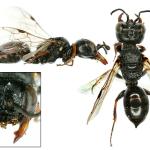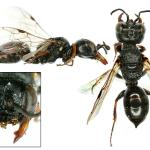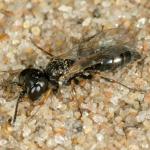Diodontus franclemonti KROMBEIN 1939
The most common British Diodontus.
Occurs from Cornwall to Kent and north through Wales to Yorkshire and the Isle of Man. Also occurs on the Channel Islands.
Common in central and southern Europe, and eastwards to Mongolia. Less common in the north (Lomholdt 1975-76).
This species is not regarded as being scarce or threatened.
Found in sandy areas, both on the coast and inland.
Late May to mid September, particularly June to July, and exceptionally found in flight as late as early October.
The prey are winged aphids (Lornholdt 1975-76).
The nests are excavated in sandy banks and slopes, with a main burrow about 10 cm long ending in a cell. Along this burrow, subsequent cells are constructed in side branches, which may themselves be branched. Altogether, up to 10-15 cells may be excavated, and each is provisioned with about 30 prey items (Lomholdt 1975-76).
No information available
None recorded from Britain, but in continental Europe, the Wasps Chysis leachii (Chrysididae) and Myrmosa atra (Mutillidae) have been recorded as parasitoids by Lomholdt (1975-76).
2002




